Triumph TR6 Cast Piston Comparison
By: Kai Radicke, Wishbone Classics
Article first published in 2008
Updated in 2010 with additional data sets and photos
Updated in 2011 with current availability / pricing
Updated in 2013 with new hardness data and revised pricing
Introduction
A number of my customers often ask what brand piston set they should purchase for their engine rebuild. Most of these questions center around quality, afterall the piston is a pretty important part of the engine. Their concern is that non-original brands that may be of lower quality than the more expensive original brands (if still in production). This article will draw comparisons between two aftermarket brand TR6 piston sets and also a set of current AE brand pistons which is considered to be the original piston manufacturer for most popular British sports cars.
Photo Comparison
Exterior Overview Photos:
|
OE Triumph (Manufactured by AE), STD Bore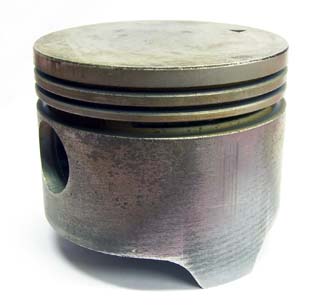
|
ACL, +020 Bore
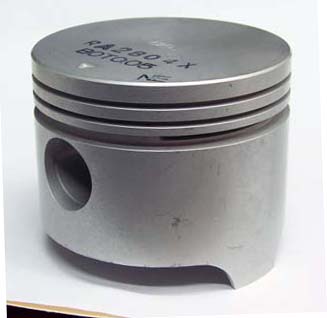 
|
AE, +020 Bore
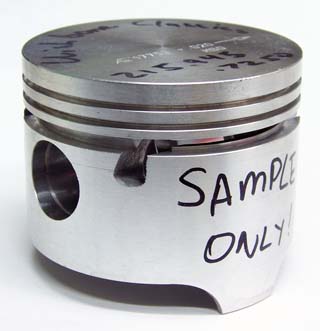
|
County, +020 Bore
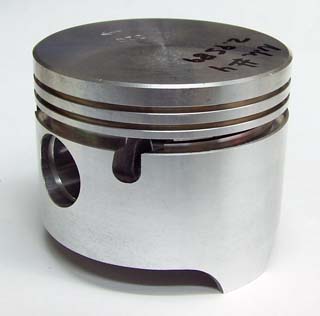
|
Interior Photos, Perspective #1:
|
OE Triumph (Manufactured by AE), STD Bore
|
ACL, +020 Bore
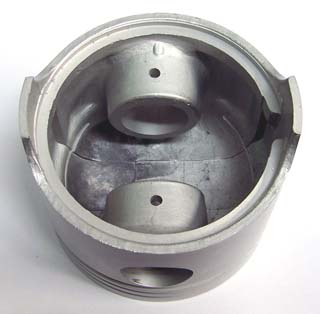
|
AE, +020 Bore
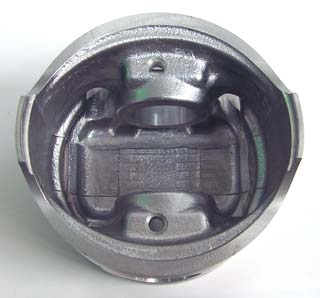
|
County, +020 Bore
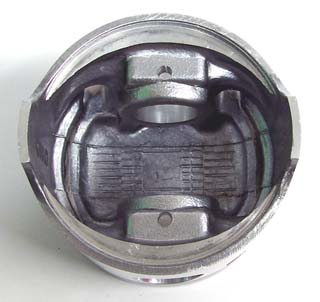
|
Interior Photos, Perspective #2:
|
OE Triumph (Manufactured by AE), STD Bore
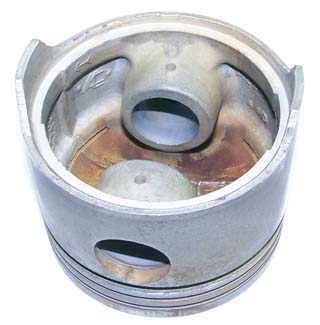

|
ACL, +020 Bore
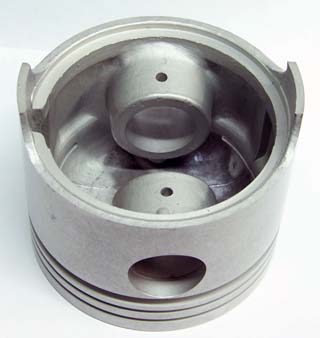
|
AE, +020 Bore
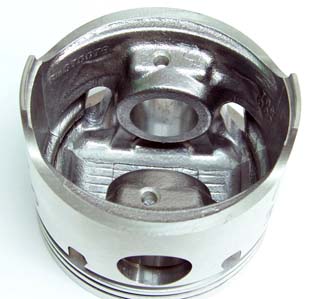
|
County, +020 Bore
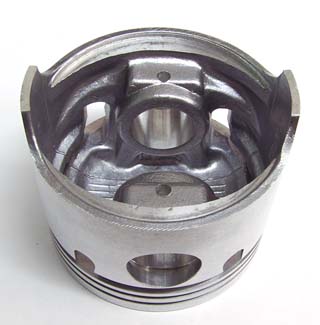
|
The obvious is that the original Triumph piston and the ACL piston are very similar, and that the AE and County piston are very similar. In fact, if I had not labelled each piston pair (OE/ACL, AE/County) you would be hard pressed to find much visual difference between them. The original TR6 piston was produced by AE for Triumph Stanpart. As these original pistons are no longer available, we will not discuss them, other than for their design to serve as a reference point for the other three brands of piston that we will discuss.
Let's start with the ACL. This is a piston set that is not readily available in the USA, ACL being an Australian auto parts company that many of you may know better by their previous name - Repco. Their TR6 piston is a copy, in terms of design, of the original Triumph piston. Significant features of the ACL piston is the lack of the oil return slots extending into the skirt body (viewed in the exterior shot above), internally, there is a large reinforcing rib that runs around the lower portion of the skirt, there is a single and relatively small supporting strut between the piston crown and wrist pin housing body. The lack of the oil return slots extending into the skirt means the piston skirt will be stiffer and can take higher thrust loads. Similarly, the large reinforcing rib stiffens the lower piston skirt (note though that the rib is open on the non-thrust side of the piston, which is slightly different than the OE TR piston). The single supporting strut between the wrist pin housing and crown underside suggests that the piston crown is not as well supported as with either the AE or County. The ACL piston is a very well cast piece, with very clean edges and very good detail.
Next the AE, which is typical of British piston designs dating to the 1970s, with the oil return slots extending into the piston skirt. There is no full circumfrence reinforcing rib along the bottom of the skirt. The wrist pin housing is supported by two substantial struts that extend up at a slight angle to support the underside of the piston crown.
Finally the County, which lets just say it, is probably a direct copy of the AE piston casting. There are a few minor differences between the AE and County, but nothing structural. The County, as their casting tooling is probably newer, is a slightly cleaner casting with certain features being more detailed than with the AE. County's piston manufacturer also machines the piston slightly differently, but we'll get to that later.
Weight & Specification Comparison:
|
|
OE Triumph, STD Bore
|
Piston (g) |
Pin (g) |
Total (g) |
|
248.8 |
93.2 |
342.0 |
Ring Pack: Chrome / Chrome / 3-Piece Oil |
|
|
ACL, +020 Bore
|
Piston (g)
|
Pin (g)
|
Total (g)
|
|
255.1
|
97.2
|
352.3
|
|
254.7
|
97.2
|
351.9
|
|
254.6
|
97.3
|
351.9
|
|
255.1
|
97.3
|
352.4
|
|
255.2
|
97.2
|
352.4
|
|
255.4
|
97.3
|
352.7
|
Bare Piston Weight Differential: 0.8g
Bare Wrist Pin Weight Differential: 0.1g
Ring Pack: Moly / Iron / 3-Piece Oil
Retail Price (Set): NLA (2011) |
AE, +020 Bore
|
Piston (g)
|
Pin (g)
|
Total (g)
|
|
278.5
|
97.6
|
376.1
|
Ring Pack: Iron / Iron / 1-Piece Oil
Retail Price (Set): $550 (Moss 2011)
|
County, +020 Bore (2008)
|
Piston (g)
|
Pin (g)
|
Total (g)
|
|
269.0
|
98.6
|
367.6
|
|
268.2
|
98.3
|
366.5
|
|
266.7
|
98.7
|
365.4
|
|
269.3
|
98.8
|
368.1
|
|
266.2
|
98.6
|
364.8
|
|
267.2
|
98.6
|
365.8
|
Bare Piston Weight Differential: 3.1g
Bare Wrist Pin Weight Differential: 0.5g
Ring Pack: Iron / Iron / 3-Piece Oil
Retail Price (Set): $310 (WBC 2011) |
|
AE, +030 Bore
|
Piston (g)
|
Pin (g)
|
Total (g)
|
|
282.6
|
98.1
|
380.7
|
|
283.7
|
97.7
|
381.4
|
|
279.2
|
98.9
|
378.1
|
|
280.2
|
98.6
|
378.8
|
|
279.5
|
97.8
|
377.3
|
|
280.1
|
97.8
|
377.9
|
Bare Piston Weight Differential: 4.5g
Bare Wrist Pin Weight Differential: 0.9g
Ring Pack: Iron / Iron / 1-Piece Oil
Retail Price (Set): $550 (Moss 2011) |
County, +040 Bore (Set A - 2009)
|
Piston (g)
|
Pin (g)
|
Total (g)
|
|
273.8 |
98.6 |
372.4 |
|
274.0 |
98.5 |
372.5 |
|
273.9 |
98.6 |
372.5 |
|
274.3 |
98.6 |
372.9 |
|
273.5 |
98.4 |
371.9 |
|
274.1 |
98.7 |
372.8 |
Bare Piston Weight Differential: 0.9g
Bare Wrist Pin Weight Differential: 0.3g
Ring Pack: Iron / Iron / 3-Piece Oil
Retail Price (Set): $310 (WBC 2011) |
County, +040 Bore (Set B - 2010)
|
Piston (g)
|
Pin (g)
|
Total (g)
|
|
276.7 |
98.3 |
375.0 |
|
276.5 |
97.9 |
374.4 |
|
276.3 |
98.4 |
374.7 |
|
276.1 |
98.6 |
374.7 |
|
276.2 |
98.0 |
374.2 |
|
276.1 |
98.8 |
374.9 |
Bare Piston Weight Differential: 0.6g
Bare Wrist Pin Weight Differential: 0.9g
Ring Pack: Iron / Iron / 3-Piece Oil
Retail Price (Set): $310 (WBC 2011) |
The results of the weight comparison probably surprised you - I bet you thought the AE set would be better balanced out of the box! This obvioulsy was not the case, and the fact that the AE wrist pins vary so much in weight is also unusual as wrist pins manufacturing is usually done to tight tolerance (recent County wrist pins also have larger mass variations than previous sets). ACL is the clear winner here for their very good consistent figures. Also, if the County piston is a copy of the AE casting, where does County save the weight for the same size piston? Well they do it on a finishing machining process that removes a good chunk of aluminum from the underside of the piston near the bottom of the skirt. If you look at the County underside photos above, you'll see this nicely undercut step area on each side above the wrist pin boss.
The make-up of the ring pack should be a huge determining factor for which piston set you purchase. Original TR6 pistons had a hard chrome faced top and second ring, and a three piece oil ring. In recent years, moly-faced rings have become popular and replaced hard chrome as a superior piston ring facing. The moly faced rings are hard wearing, very durable, seal better and have a lower coefficient of friction than their plain iron. Three piece oil rings again are superior to single piece rings, as a three piece ring has puts lets tension on the cylinder wall (lower friction) and is more efficient at controlling the oil fillm on the cylinder walls. It should also be noted that a single piece iron oil ring is substantially heavier than a three piece unit.
Again, ACL takes the cake here for having the best ring package out of the box. County would follow up in second as it includes a nice three piece oil ring setup. And in last place, AE. Despite being the most expensive piston set the AE comes with the cheapest and least desirable set of rings.
Quality & Consistency
The ACL pistons are quite consistent across the limited number of sets that have come into my posession. You will need to carefully clean the areas in between the ring lands (where the piston ring seats), with a nylon bristle brush and soapy water. On a few occasions, machining swarth from the piston ring grooving process has been found. Note too, that on a recent set of customer supplied $950 JE custom pistons, that the same issue was found with each of the JE pistons! Other than that, the casting qualtiy is very clean on the ACL pistons with no additional work needing to be done to make it a drop in part.
The AE pistons are machined accurately and consistently. The AE pistons do have a textured surface on the skirts, which I propose is deliberate as it matches the type of surface seen on most current forged pistons. I would suspect that the finish allows greater amounts of oil to be held on the skirt surface, resulting in less piston to bore contact. Where AE does their machining, the edges are nicely deburred and for the most part free of machining debris.
The County pistons are a slightly cleaner, more detailed casting than the AE, but unfortunately County's machining consistency leaves something to be desired. I often find the bottom edge of the County piston to be a little rougher than I prefer, and I spend about 10-15 minutes per set to deburr the edge to my liking. I consider this trivial, and more about my own obsessive nature than a fault with how the part. However, of greater importance, since I have started using and selling County TR6 piston sets, around January of 2005, I have had to reject a few sets of pistons because of a peculliar issue with how the skirt is machined. It seems that County's manufacturer machines one half of the piston outside diameter on a lathe. Because a portion of the outside has to be inserted into the chuck of the lathe, they flip the piston over, rechuck it, and finish machining the portion that needs finishing. There is nothing wrong with doign it this way, but the faulty pistons each had mismatched machining steps in the skirt.
The defect, when it occurs, is readily visible out of the box. I and my staff thoroughly inspect parts entering our stock, each of these three pistons (happening in three distinct piston sets over a period of two years), was caught at our door. The defect is pretty rare based on the volume of County pistons we go through, but nonetheless, I have never seen an AE piston with the same issue. You simply need to check your County pistons should you receive them fron another supplier who does not thoroughly check their stocked parts for defects.
County Skirt Machining Defect Photo:
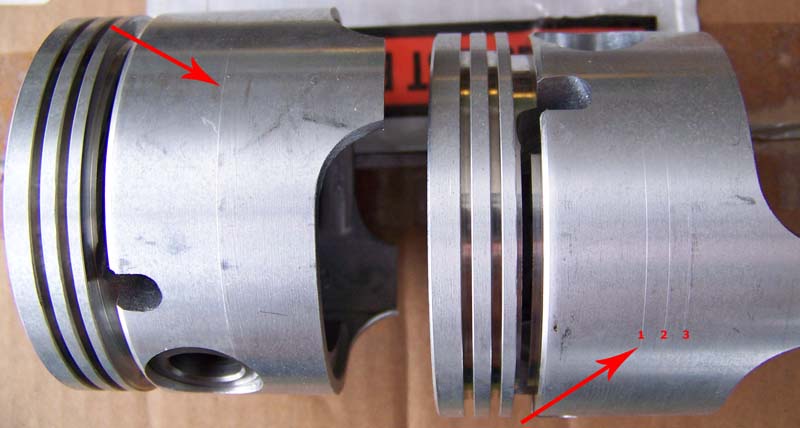

Durability, Hardness and Heat Treatment
Numerous sources have claimed to us the County piston is tolerant of withstanding higher compression ratios than the AE piston. Silicon is used in pistons to control piston thermal expansion and to increase the hardness of the alloy to offer better wear resistance, primarily of the piston skirt and piston ring grooves. Piston skirt wear is not a major issue on the TR6 engine, and a harder alloy solely for the benefit of improved wear resistance is not a significantly desirable attribute when shopping for TR6 pistons. However, harder pistons are more brittle which means they are far easier to damage as a result of pre-ignition or detonation. Engines configured with higher compression ratios are more likely to experience irregular combustion and thus more likely to cause damage to their pistons. We have safely used the County pistons upto 10.5:1 static compression ratios, but always with properly tuned performance ignition systems. A safe threshold for most cast pistons is around 10:1, beyond that one should be considering forged pistons as a more appropriate performance option.
While the earlier versions of this article did not discuss the qualities of the aluminum alloy, my curiosity got the better of me and I tested a number of TR6 pistons I had on hand. The results were surprising! I performed the hardness testing using the Rockwell B scale which is used for soft metals.
|
|
Hardness (HRB - Rockwell B) |
Hardness (BHN - Brinnel)
converted from HRB
|
|
ACL, +020 |
HRB 56-61 |
BHN 89-96 |
|
AE, +020 |
HRB 42-47 |
BHN 76-80 |
|
AE, +030 |
HRB 50-52 |
BHN 83-85 |
|
County, +040 (Set 1) |
HRB 65-68 |
BHN 102-107 |
|
County, +040 (Set 2) |
HRB 65-70 |
BHN 102-110 |
You'll notice that the AE pistons are by far the softest and the County pistons the harder of the bunch. Some of this is likely down to the specific alloy composition. Aluminum alloys with higher amounts of silicon tend to be harder. Additionally, the heat treatment process being employed by each manufacturer will provide different strength levels and therefore the hardnesses will vary. Harder reads do indicate greater material strength, but with a loss of ductility.
I did not expect to see the AE pistons measure in at such a soft level. Finding industry specifications on the heat treating and hardness of the pistons to find some concrete benchmark data is difficult. Fortunately, ACL publishes some information that helps fill in that blank. ACL equates a hardness of BHN 90-120 as corresponding to their T5 heat treatment, and a hardness of BHN 105-130 to their T6 heat treatment process. Neither figure makes mention of the specific alloy composition, which will also dictate the final hardness and strength characteristics. With that said, we find the ACL TR6 pistons I tested do fall into the lower range of ACL's hardness range for a T5 heat treated piston. While the County pistons fall into a middle range that overlaps both heat treatment specs. What is peculiar is that the AE pistons are soundly considered soft by ACL's published hardness specifications. I too was taken aback by how soft the AE pistons tested, even before having concrete industry figures.
(section incomplete - more information pending)
My Recommendation
As I stated before, ACL TR6 piston sets are not readily available in the USA. As of March 2008, I am down to one set, the one used for reference here. As such, I have to consider the ACL brand TR6 piston as NLA - No Longer Available, and I cannot recommend a product that is not readily available for purchase. Additionally, as of 2011, it seems ACL has left the piston business entirely.
That narrows it down to AE and County, with the biggest descrepancy that matters being the $240 base price difference between the two. If you are already an engine customer of Wishbone Classics, you'll know my preference is for the cheaper County piston set. I still hear objections towards my choice from hardcore British car faithful that have it engrained that original branded parts are always best. I have no problem with using an AE piston set, as long as the customer has no problem paying for the AE set and purchasing a better set of piston rings than what AE supplies. Given that argument, lets see what it takes to make the AE and County "equal" products.
|
AE TR6 Piston Set
|
County TR6 Piston Set
|
|
Set Purchase Price |
$550 (Moss 2013)
|
Set Purchase Price |
$300 (WBC 2013)
|
|
Deburr Labor |
0 (OK as received) |
Deburr Labor |
+ $20 (15 mins) * |
|
Balancing |
+ $40 (30 mins) * |
Balancing |
0 (not often required) |
|
Three Piece Oil Ring |
+ $70 ** |
Three Piece Oil Ring |
0 (included with set) |
|
Total |
$660 |
Total |
$320 |
* Based on our current labor rate of $80/hour (March 2008)
** Price is for a complete piston ring set, as piston rings are not sold individually |
As you can hopefully see, by choosing the County piston set save a half the price over an equivalently spec'd AE piston set. That savings can either be used to keep the overall cost of the engine rebuild low or put towards improving the specification in another area where the the investment of $300+ has greater potential.
The most important bit of information I have to relate is that in use, I can say there is no disinguishable difference between an AE and County set (both using three piece oil rings). If you opt to use an AE set with the standard supplied single piece iron ring, you will experience greater levels of friction on your cylinder walls which not only consumes power but also increases wear. All cast pistons installed in engines with high compressions need careful tuning and consideration in the ignition department. Forged pistons are stronger and more durable in high performance engines. But for stock and mildly built street engines, there is nothing wrong with a good set of cast pistons.
Verdict: County, just be cognizant of potential quality issues and check your parts when you receive them!
|

